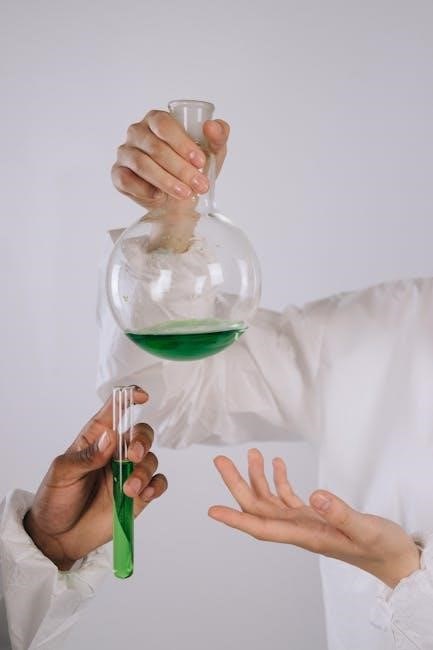A limiting reagent is the reactant that is completely consumed in a chemical reaction, determining the product amount. It is essential for stoichiometric calculations and optimizing reactions.
1.1 Definition of a Limiting Reagent
A limiting reagent, also known as the limiting reactant, is the substance in a chemical reaction that is entirely consumed, dictating the maximum amount of product formed. It is the reactant that runs out first, halting the reaction. Identifying the limiting reagent is crucial for stoichiometric calculations, as it determines the theoretical yield of products. For example, in a reaction involving aluminum and hydrobromic acid, the reactant that is completely used up governs the reaction’s outcome. Understanding this concept is fundamental for optimizing chemical processes and predicting results accurately.
1.2 Importance of Limiting Reagents in Chemical Reactions
Limiting reagents are crucial in chemical reactions as they determine the maximum product yield. Identifying them ensures efficient use of resources, minimizing waste and costs. In industry, this optimizes manufacturing processes. Academically, it aids in solving stoichiometry problems, enhancing understanding of reaction dynamics. Knowing the limiting reagent allows scaling reactions safely and efficiently, avoiding excess reactants that could pose environmental or safety risks. This concept is fundamental for both theoretical understanding and practical applications in chemistry, ensuring accurate predictions and successful experimentation.

Understanding Limiting Reagent Calculations
Limiting reagent calculations are crucial for stoichiometry, involving converting masses to moles, comparing mole ratios, and identifying the reactant that limits product formation. These steps ensure accurate predictions of reaction outcomes.
2.1 Steps to Identify the Limiting Reagent
Identifying the limiting reagent involves several key steps. First, ensure the chemical equation is balanced. Next, convert the masses of reactants to moles using molar masses. Then, compare the mole ratio of reactants to the stoichiometric ratio required by the balanced equation. The reactant with a mole ratio less than the required ratio is the limiting reagent. This step-by-step approach ensures accurate determination of the limiting reactant, which is essential for calculating the maximum product formation and understanding reaction efficiency. Proper documentation and verification are recommended to avoid errors in calculations.
2.2 Converting Mass to Moles
Converting mass to moles is a critical step in limiting reagent calculations. To do this, divide the given mass of each reactant by its molar mass, which is found on the periodic table. For example, if you have 10.0 g of aluminum (Al), its molar mass is approximately 27 g/mol, so the moles of Al would be 10.0 g / 27 g/mol = ~0.37 mol. This conversion allows you to work with the stoichiometric ratios in the balanced chemical equation, enabling accurate identification of the limiting reagent and calculation of product amounts. Always ensure units are consistent and calculations are precise to avoid errors.
2.3 Comparing Mole Ratios
After converting masses to moles, compare the mole ratios of the reactants to the coefficients in the balanced equation. For example, if the reaction requires a 2:1 mole ratio of Al to HBr, calculate the available moles of each reactant. Divide each by their respective coefficients to determine which reactant will be depleted first. The reactant with the smallest ratio is the limiting reagent. This step ensures accurate identification of the limiting reagent, allowing for precise calculations of product yields and remaining excess reactants. Carefully document each comparison to avoid miscalculations and ensure reliable results.

Limiting Reagent Worksheet Examples
This section provides detailed examples from limiting reagent worksheets, offering practical problems and solutions to understand the concept. It includes reactions like Aluminum and Hydrobromic Acid, Magnesium and Oxygen, and Propane combustion, helping students apply stoichiometric principles effectively.
3.1 Example 1: Reacting Aluminum and Hydrobromic Acid
Given the reaction:
2 Al + 6 HBr → 2 AlBr₃ + 3 H₂
– Initial moles: 3.22 mol Al, 4.96 mol HBr
– Stoichiometric ratio: 1:3 (Al:HBr)
a) Moles of H₂ produced:
Using HBr as the limiting reagent:
4.96 mol HBr * (3 mol H₂ / 6 mol HBr) = 2.48 mol H₂
b) Limiting reactant: HBr
c) Excess reactant (Al) left over:
Moles of Al consumed = (2 mol Al / 6 mol HBr) * 4.96 mol HBr ≈ 1.653 mol Al
Moles of Al remaining = 3.22 mol ⎻ 1.653 mol ≈ 1.567 mol Al
Thus, 2.48 moles of H₂ are formed, HBr is the limiting reactant, and approximately 1.567 moles of Al remain unreacted.
3.2 Example 2: Reaction of Magnesium with Oxygen
Consider the reaction:
2 Mg + O₂ → 2 MgO
– Initial amounts: 2.2 g Mg, 4.5 L O₂ at STP
– Moles of Mg = 2.2 g / 24.3 g/mol ≈ 0.09 mol
– Moles of O₂ = 4.5 L / 22.4 L/mol ≈ 0.2 mol
Using the stoichiometric ratio (2:1), calculate the required moles of O₂ for 0.09 mol Mg:
0.09 mol Mg * (1 mol O₂ / 2 mol Mg) = 0.045 mol O₂ needed
Since 0.2 mol O₂ is available, Mg is the limiting reactant.
Moles of MgO formed = 0.09 mol Mg * (1 mol MgO / 1 mol Mg) = 0.09 mol MgO
Mass of MgO = 0.09 mol * 40.3 g/mol ≈ 3.62 g
Thus, magnesium is the limiting reagent, and 3.62 g of MgO is produced.
3.3 Example 3: Combustion of Propane
Consider the combustion of propane:
C₃H₈ + 5 O₂ → 3 CO₂ + 4 H₂O
– Initial amounts: 80.0 g C₃H₈, 16.3 g H₂O
– Molar masses: C₃H₈ = 44.1 g/mol, H₂O = 18.0 g/mol
– Moles of C₃H₈ = 80.0 g / 44.1 g/mol ≈ 1.81 mol
– Moles of H₂O = 16.3 g / 18.0 g/mol ≈ 0.905 mol
Using the stoichiometric ratio (1:5), calculate the required moles of O₂ for each reactant.
C₃H₈ requires = 1.81 mol * 5 = 9.05 mol O₂
H₂O requires = 0.905 mol * 5 = 4.53 mol O₂
Since H₂O requires less O₂, it is the limiting reactant.
Moles of H₂ produced = 0.905 mol H₂O * (4 mol H₂ / 4 mol H₂O) = 0.905 mol H₂
Volume of H₂ at STP = 0.905 mol * 22.4 L/mol ≈ 20.3 L
Thus, water is the limiting reagent, and 20.3 L of hydrogen gas is produced.

Solving Limiting Reagent Problems
To solve limiting reagent problems, balance the chemical equation, convert reactant masses to moles, compare mole ratios to identify the limiting reagent, calculate the theoretical yield of products, and determine excess reactants.
4.1 Calculating Moles of Reactants
Calculating moles of reactants involves dividing the given mass of each reactant by its molar mass. This step is crucial for determining the limiting reagent. For example, to find moles of aluminum (Al) in a reaction, divide the mass of Al by its molar mass (27 g/mol). Similarly, for hydrobromic acid (HBr), divide the mass by 80.9 g/mol. Accurate mole calculations ensure precise identification of the limiting reagent and the theoretical yield of products. This foundational step is essential for solving stoichiometry problems effectively;
4.2 Determining the Limiting Reactant
Determining the limiting reactant involves comparing mole ratios of reactants to their stoichiometric coefficients. After converting masses to moles, divide each by its coefficient in the balanced equation. The reactant with the smallest ratio is the limiting reagent. For instance, in the reaction 2Al + 6HBr → 2AlBr₃ + 3H₂, if 3.22 moles of Al and 4.96 moles of HBr are used, calculate their ratios (Al: 3.22/2 = 1.61; HBr: 4.96/6 ≈ 0.827). Since HBr has the lower ratio, it is the limiting reactant. This step ensures accurate prediction of reaction outcomes.
4.3 Calculating Excess Reactant Left Over
After identifying the limiting reagent, calculate the excess reactant remaining. Use stoichiometry to find the theoretical yield of the product, then determine how much reactant was consumed. Subtract the consumed amount from the initial amount of the excess reactant to find the leftover quantity. For example, in the reaction 2Al + 6HBr → 2AlBr₃ + 3H₂, if 3.22 moles of Al and 4.96 moles of HBr are used, and HBr is the limiting reagent, calculate the moles of Al consumed (3.22/2 = 1.61 moles of HBr consumed). The remaining HBr is 4.96 ౼ 1.61 = 3.35 moles. This step ensures accurate quantification of leftover reactants.
Limiting Reagent Answer Sheets
Answer sheets provide step-by-step solutions and final answers for limiting reagent problems, ensuring accuracy and clarity. They verify calculations and help students master stoichiometric concepts effectively.
5.1 Key Features of Answer Sheets
Answer sheets for limiting reagent problems typically include detailed step-by-step solutions, final numerical answers, and explanations of calculations. They highlight the limiting reagent, the excess reactant, and the theoretical yield of products. These sheets often provide balanced chemical equations, mole-to-mass conversions, and comparison of mole ratios. They also clarify common mistakes, such as incorrect stoichiometric ratios or forgetting to convert grams to moles. Additionally, they may include graphical representations or charts to simplify complex calculations, ensuring students understand each step logically and systematically.
5.2 How to Use Answer Sheets for Verification
Answer sheets are invaluable for verifying solutions to limiting reagent problems. Students can compare their calculations with the provided answers to identify errors. By reviewing step-by-step solutions, they can trace where mistakes occurred, such as incorrect mole ratios or unit conversions. Answer sheets also help confirm the correct identification of the limiting reagent and excess reactant. Regular use enhances problem-solving skills and understanding of stoichiometric principles, ensuring accuracy in future calculations. They serve as a reliable tool for self-assessment and improvement in mastering limiting reagent concepts.

Common Mistakes in Limiting Reagent Problems
Common errors include forgetting to balance chemical equations, miscalculating mole ratios, and neglecting to account for excess reactants. These mistakes can lead to incorrect conclusions about the limiting reagent and product amounts. Careful attention to stoichiometric details and thorough documentation of steps help minimize these errors.
6.1 Forgetting to Balance the Chemical Equation
Forgetting to balance the chemical equation is a common mistake that can lead to incorrect mole ratios and product calculations. Always ensure the equation is balanced before proceeding with stoichiometric calculations. This step is crucial as it determines the correct mole ratios between reactants and products. Neglecting this can result in erroneous identification of the limiting reagent and incorrect product yields. Proper balancing ensures accurate calculations and helps avoid confusion in determining excess reactants. Always double-check the balanced equation to maintain precision in limiting reagent problems.
6.2 Incorrect Mole Ratio Calculations
Incorrect mole ratio calculations are a frequent error in limiting reagent problems. This often occurs when converting masses to moles or using the wrong stoichiometric coefficients. For example, using unbalanced equations or misapplying mole-to-mole relationships can lead to inaccurate results. Such errors can misidentify the limiting reagent or miscalculate product yields. To avoid this, always ensure mole ratios are derived from balanced equations and double-check unit conversions. Pay attention to significant figures and proper rounding to maintain precision. Accurate mole ratio calculations are critical for correctly identifying the limiting reagent and determining the theoretical yield of products.
6.3 Neglecting Excess Reactant Calculations
One common mistake is neglecting to calculate the amount of excess reactant left over after a reaction. This oversight can lead to incomplete solutions, as many problems require determining both the limiting reagent and the remaining excess. To avoid this error, always perform a mass or mole comparison after identifying the limiting reagent. Calculate how much of the excess reactant is consumed and subtract this from the initial amount to find the leftover quantity. This step ensures a comprehensive understanding of the reaction’s stoichiometry and verifies the accuracy of the limiting reagent identification. Proper documentation of these calculations is essential for clarity and correctness.

Best Practices for Limiting Reagent Worksheets
Ensure accurate calculations by converting masses to moles and comparing ratios. Clearly document steps, including balanced equations and mole-to-mass conversions, for transparency and verification.
7.1 Ensuring Accurate Calculations
Accurate calculations are crucial in limiting reagent problems. Start by balancing the chemical equation to determine mole ratios. Convert the mass of each reactant to moles using molar masses. Compare the mole ratio of reactants to the balanced equation to identify the limiting reagent. Calculate theoretical yields and verify excess reactant amounts. Double-checking calculations ensures precision, especially in complex reactions with multiple steps or reactants. Using stoichiometry correctly helps avoid errors and ensures reliable results for both academic and practical applications.
7.2 Clear Documentation of Steps
Clear documentation ensures transparency and accuracy in limiting reagent problems. Always record every step, from balancing equations to final calculations. Show mole-to-mass conversions and highlight the limiting reagent. Document theoretical yields and excess reactants. Organize results neatly, making it easy to review and verify. Include balanced equations, mole ratios, and calculations for each reactant. This structured approach helps identify errors and enhances understanding. Cross-referencing with answer keys or solutions ensures accuracy and reinforces learning, making worksheets a valuable tool for mastering stoichiometry and limiting reagent concepts.

Advanced Limiting Reagent Scenarios
Advanced scenarios involve complex reactions with multiple reactants, gas-phase interactions, and dilution factors. These require precise stoichiometric calculations and considerations of concentration and volume to identify limiting reagents accurately.
8.1 Reactions with Multiple Reactants
In reactions involving multiple reactants, determining the limiting reagent becomes complex due to varying stoichiometric ratios. Each reactant’s mole ratio must be compared to the balanced equation to identify which is limiting. For example, in C3H8 + 5O2 → 3CO2 + 4H2O, calculating moles of each reactant and comparing to coefficients reveals the limiting reagent. Worksheets provide structured approaches to such problems, ensuring accurate identification and minimizing errors in multi-reactant scenarios. This skill is crucial for mastering stoichiometry in advanced chemical reactions.
8.2 Gas-Phase Reactions
Gas-phase reactions involve reactants in the gaseous state, requiring careful application of stoichiometric principles. The limiting reagent is determined by comparing mole ratios of gaseous reactants, often using volume ratios at constant temperature and pressure. For example, in 2NO(g) + O2(g) → 2NO2(g), volumes of NO and O2 are compared to identify the limiting reactant. Worksheets provide structured problems, such as calculating moles of gas reacting or excess gas remaining. These problems enhance understanding of gas-phase stoichiometry and practical applications in industrial chemistry, emphasizing precise calculations and attention to reaction conditions.
8.3 Solutions and Dilutions
Limiting reagent calculations in solutions involve determining reactant availability based on concentration and volume. For example, in reactions like Al + HBr → AlBr3 + H2, the moles of each reactant are calculated using molarity and volume. Dilutions can affect the amount of reactants available, influencing the limiting reagent. Worksheets often include problems where students calculate the moles of solute in solution and compare them to identify the limiting reactant. This applies to acid-base, precipitation, and redox reactions, emphasizing the importance of accurate concentration and volume measurements to determine the limiting reagent and predict reaction outcomes effectively.

Limiting Reagent Worksheets with Answers
These worksheets provide structured problems and step-by-step solutions, helping students master stoichiometry and limiting reagent calculations. They include practical examples, answers, and explanations for clarity and understanding.
9.1 Finding Reliable Worksheets Online
Reliable worksheets on limiting reagents are widely available online, offering structured problems and solutions for practice. Educational websites, such as those from schools like Dougherty Valley HS and Everett Community College, provide detailed exercises. These resources often include balanced equations, mole calculations, and step-by-step answers. Worksheets like “Limiting Reagent Worksheet 1” and “Chemistry Worksheet: Limiting Reactant” are popular for their clarity and comprehensiveness. Students can also find PDF documents with answers, enabling self-assessment. These tools are invaluable for mastering stoichiometry and reaction calculations, ensuring a strong foundation in chemistry concepts.
9.2 Using Worksheets for Practice
Worksheets are invaluable for practicing limiting reagent problems, helping students master stoichiometry and reaction calculations. They provide structured exercises with clear questions, enabling hands-on application of concepts. By working through problems, students improve their ability to identify limiting reactants, calculate moles, and determine excess quantities. Answer keys allow for self-assessment, reinforcing understanding. Regular practice with worksheets enhances problem-solving skills and confidence in handling complex chemical reactions. They are an essential tool for students aiming to excel in chemistry, offering a practical way to apply theoretical knowledge to real-world scenarios. Consistent practice ensures mastery of limiting reagent calculations and reaction stoichiometry.
Mastering limiting reagent calculations is essential for understanding chemical reactions and stoichiometry. Worksheets with answers provide a practical way to practice and reinforce these concepts. By solving problems, students gain confidence in identifying limiting reagents, calculating moles, and determining excess reactants. These skills are vital for optimizing reactions and reducing waste in industrial processes. Regular practice with worksheets ensures a deep understanding of reaction dynamics, enabling students to approach complex problems with precision and accuracy. Ultimately, limiting reagent worksheets are a valuable tool for achieving proficiency in chemistry and applying theoretical knowledge to real-world scenarios.

Additional Resources
11.1 Textbooks on Stoichiometry
Textbooks like “Chemical Stoichiometry” and online resources provide detailed explanations and practice problems on limiting reagents.
11.2 Online Limiting Reagent Calculators
Utilize online calculators and worksheets with answers to verify calculations and deepen understanding of limiting reagent concepts.
Textbooks such as “Chemical Stoichiometry” and “General Chemistry: Principles, Patterns, and Applications” offer comprehensive guides to understanding limiting reagents. These resources provide detailed explanations of stoichiometric principles, practical examples, and practice problems to master the concept of limiting reagents. Many textbooks include worksheets with answers, allowing students to verify their calculations and improve problem-solving skills. Additionally, they cover advanced topics like multi-reactant systems and gas-phase reactions, ensuring a thorough understanding of chemical reactions and their applications.
Online limiting reagent calculators are invaluable tools for students and professionals alike, offering quick and accurate solutions to stoichiometric problems. Websites like Calculator.net and ChemCalculations provide user-friendly interfaces where users can input reaction data, including moles, masses, and balanced equations, to determine the limiting reagent and theoretical yields. These calculators often include step-by-step explanations, making them excellent resources for learning and verification. They are particularly useful for complex reactions or when dealing with multiple reactants, ensuring precise calculations and saving time in academic and professional settings.

Final Thoughts
Online limiting reagent calculators simplify complex stoichiometric problems, providing quick and accurate results. Websites like Calculator.net and ChemCalculations offer tools where users can input reaction details, such as moles, masses, and balanced equations, to identify the limiting reagent and calculate theoretical yields. These platforms often include step-by-step explanations, making them ideal for learning and verification. They are particularly useful for complex reactions or multiple reactants, ensuring precise calculations and saving time. Students and professionals alike benefit from these resources, enhancing their understanding and efficiency in chemical problem-solving.
